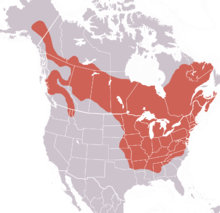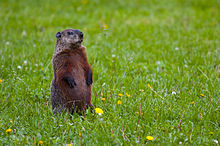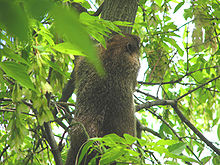- Groundhog
-
For other uses, see groundhog (disambiguation) and woodchuck (disambiguation).
Groundhog 
Conservation status Scientific classification Kingdom: Animalia Phylum: Chordata Class: Mammalia Order: Rodentia Family: Sciuridae Genus: Marmota Species: M. monax Binomial name Marmota monax
(Linnaeus, 1758)Subspecies - M. m. monax Linnaeus, 1758
- M. m. canadensis Erxleben, 1777
- M. m. ignava Bangs, 1899
- M. m. rufescens A. H. Howell, 1914

Groundhog range The groundhog (Marmota monax), also known as a woodchuck, whistle-pig, or in some areas as a land-beaver, is a rodent of the family Sciuridae, belonging to the group of large ground squirrels known as marmots. Other marmots, such as the yellow-bellied and hoary marmots, live in rocky and mountainous areas, but the woodchuck is a lowland creature. It is widely distributed in North America and common in the northeastern and central United States. Groundhogs are found as far north as Alaska, with their habitat extending southeast to Alabama.[2]
Contents
Description
The groundhog is the largest sciurid in its geographical range, typically measuring 40 to 65 cm (16 to 26 in) long (including a 15 cm (6 in) tail) and weighing 2 to 4 kg (4 to 9 lb). In areas with fewer natural predators and large amounts of alfalfa, groundhogs can grow to 80 cm (30 in) and 14 kg (31 lb). Groundhogs are well adapted for digging, with short but powerful limbs and curved, thick claws. Unlike other sciurids, the groundhog's spine is curved, more like that of a mole, and the tail is comparably shorter as well—only about one-fourth of body length. Suited to their temperate habitat, groundhogs are covered with two coats of fur: a dense grey undercoat and a longer coat of banded guard hairs that gives the groundhog its distinctive "frosted" appearance.
Survival
In the wild, groundhogs can live up to six years, with two or three being average. In captivity, groundhogs are reported to live from 9-14 years, with the original Wiarton Willie being said[3] to have lived for 22. Common predators for groundhogs include wolves, coyotes, foxes, bobcats, bears, large hawks, and dogs. Young groundhogs are often at risk for predation by snakes, which easily enter the burrow.
Diet
Feeding
Mostly herbivorous, groundhogs primarily eat wild grasses and other vegetation, including berries and agricultural crops, when available.[4] Groundhogs also eat grubs, grasshoppers, insects, snails and other small animals, but are not as omnivorous as many other sciuridae. Like squirrels they also have been observed sitting up eating nuts such as shagbark hickory but unlike squirrels do not bury them for future use. Groundhogs hydrate through eating leafy plants rather than from a natural water source.
Burrows
Groundhogs are excellent burrowers, using burrows for sleeping, rearing young, and hibernating. The average groundhog has been estimated to move approximately 1 m3 (35 cu ft), or 320 kg (710 lb), of dirt when digging a burrow. Though groundhogs are the most solitary of the marmots, several individuals may occupy the same burrow. Groundhog burrows usually have two to five entrances, providing groundhogs their primary means of escape from predators. Burrows are particularly large, with up to 14 metres (46 ft) of tunnels buried up to 1.5 metres (5 ft) underground, and can pose a serious threat to agricultural and residential development by damaging farm machinery and even undermining building foundations.[5]
Behavior
Groundhogs are one of the few species that enter into true hibernation, and often build a separate "winter burrow" for this purpose. This burrow is usually in a wooded or brushy area and is dug below the frost line and remains at a stable temperature well above freezing during the winter months. In most areas, groundhogs hibernate from October to March or April, but in more temperate areas, they may hibernate as little as 3 months.[6] To survive the winter, they are at their maximum weight shortly before entering hibernation. They emerge from hibernation with some remaining body fat to live on until the warmer spring weather produces abundant plant materials for food. Groundhogs are mostly diurnal.
Despite their heavy-bodied appearance, groundhogs are accomplished swimmers and excellent tree climbers when escaping predators or when they want to survey their surroundings.[7] They prefer to retreat to their burrows when threatened; if the burrow is invaded, the groundhog tenaciously defends itself with its two large incisors and front claws. Groundhogs are generally agonistic and territorial among their own species, and may skirmish to establish dominance.[4]
Outside their burrow, individuals are alert when not actively feeding. It is common to see one or more nearly-motionless individuals standing erect on their hind feet watching for danger. When alarmed, they use a high-pitched whistle to warn the rest of the colony, hence the name "whistle-pig".[5][8] Groundhogs may squeal when fighting, seriously injured, or caught by an enemy.[8] Other sounds groundhogs may make are low barks and a sound produced by grinding their teeth.[8] When groundhogs are frightened, the hairs of the tail stand straight up, giving the tail the appearance of a hair brush.
Reproduction
Usually groundhogs breed in their second year, but a small proportion may breed in their first. The breeding season extends from early March to mid- or late April, after hibernation. A mated pair remains in the same den throughout the 31–32 day[9] gestation period. As birth of the young approaches in April or May, the male leaves the den. One litter is produced annually, usually containing 2–6 blind, hairless and helpless young. Young groundhogs are weaned and ready to seek their own dens at five to six weeks of age.
Range
The groundhog prefers open country and the edges of woodland, and it is rarely far from a burrow entrance. Since the clearing of forests provided it with much more suitable habitat, the groundhog population is probably higher now than it was before the arrival of European settlers in North America. Groundhogs are often hunted for sport, which tends to control their numbers. However, their ability to reproduce quickly has tended to mitigate the depopulating effects of sport hunting.[5] As a consequence, the groundhog is a familiar animal to many people in the United States and Canada.
Human relevance
Groundhogs raised in captivity can be socialized relatively easily; however, their aggressive nature can pose problems. Doug Schwartz, a zookeeper and groundhog trainer at the Staten Island Zoo, has been quoted as saying "They’re known for their aggression, so you’re starting from a hard place. [Their] natural impulse is to kill ’em all and let God sort ’em out. You have to work to produce the sweet and cuddly."[10]
In the United States and Canada, the yearly Groundhog Day celebration has given the groundhog recognition and popularity, as has the movie of the same name. The most popularly known of these groundhogs are Wiarton Willie and Punxsutawney Phil, well kept as part of Groundhog Day festivities in Wiarton, Ontario and Punxsutawney, Pennsylvania, respectively. A famous southern groundhog, General Beauregard Lee, is based at the Yellow River Game Ranch outside Atlanta, Georgia. His forecasts are also very popular in the Southeast.
Woodchucks are used in medical research on hepatitis B-induced liver cancer. When infected with Woodchuck Hepatitis B virus they are at 100% risk for developing liver cancer, making them a good model for testing Hepatitis B and liver cancer therapies.
Groundhog burrows have been known to reveal at least one archaeological site, the Ufferman Site in the U.S. state of Ohio.[11] Although archaeologists have never excavated the Ufferman Site, numerous artifacts have been found because of the activities of local groundhogs. They favor the loose soil of the esker upon which the site lies, and their many diggings for their burrows have brought to the surface significant numbers of human and animal bones, pottery, and bits of stone.[11]
Etymology
The etymology of the name woodchuck is unrelated to wood or chucking. It stems from an Algonquian (possibly Narragansett) name for the animal, wuchak. The similarity between the words has led to the common tongue-twister:
- How much wood would a woodchuck chuck
- if a woodchuck could chuck wood?
- A woodchuck would chuck all the wood he could
- if a woodchuck could chuck wood![12]
References
- ^ Linzey, A. V. & NatureServe (Hammerson, G. & Cannings, S.) (2008). Marmota monax. In: IUCN 2008. IUCN Red List of Threatened Species. Downloaded on 6 January 2009.
- ^ Marmota monax (Linnaeus); Woodchuck. Pick4.pick.uga.edu. Retrieved on 2011-09-15.
- ^ What Wiarton Willie sees, CBC News Canada online, February 2, 2011
- ^ a b Whitaker, John O; Hamilton, W J. (1998). Mammals of the Eastern United States. Cornell University Press. ISBN 0801434750.
- ^ a b c Light, Jessica E.. "Animal Diversity Web: Marmota monax". University of Michigan Museum of Zoology. http://animaldiversity.ummz.umich.edu/site/accounts/information/Marmota_monax.html. Retrieved 2009-07-14.
- ^ Woodchucks in Rhode Island. (PDF) . dem.ri.gov. Retrieved on 2011-09-15.
- ^ Chapman, J.A.; Feldhammer, G.A. (1982). Wild Mammals of North America, Biology, Management, Economics. Johns Hopkins University Press.
- ^ a b c Hinterland Who's Who ("Canadian Wildlife Service: Mammals: Woodchuck"). Hww.ca. Retrieved on 2011-09-15.
- ^ Woodchuck. Marmota monax. (PDF). North Caroline Wildlife
- ^ Newman, Andy (01-12-2007), "Grooming a Weatherman for his TV Debut, and Hoping He Doesn't Bite The Host", The New York Times, http://www.nytimes.com/2007/01/12/nyregion/12groundhog.html?_r=1
- ^ a b Owen, Lorrie K., ed. Dictionary of Ohio Historic Places. Vol. 1. St. Clair Shores: Somerset, 1999, 328.
- ^ Lyrics and Words for Children's Nursery Rhymes and Songs. BusSongs.com. Retrieved on 2011-09-15.
External links
- Hinterland Who's Who ("Canadian Wildlife Service: Mammals: Woodchuck")
- Missouri Conservation Commission ("Woodchuck")
Categories:- IUCN Red List least concern species
- Marmots
- Mammals of Canada
- Mammals of the United States
- Fauna of Delaware and Maryland
- Fauna of the Northeastern United States
- Animals described in 1758
Wikimedia Foundation. 2010.




